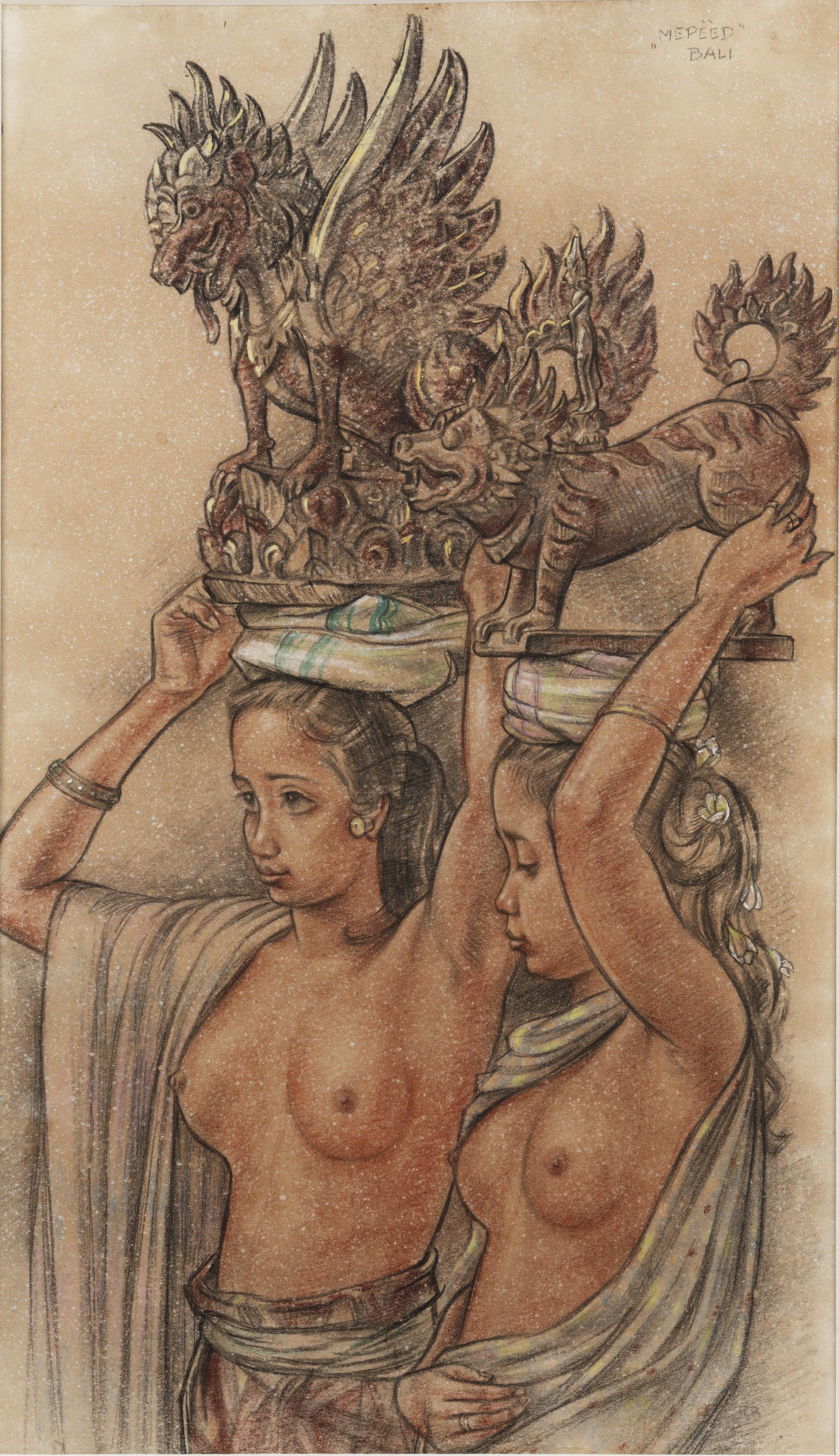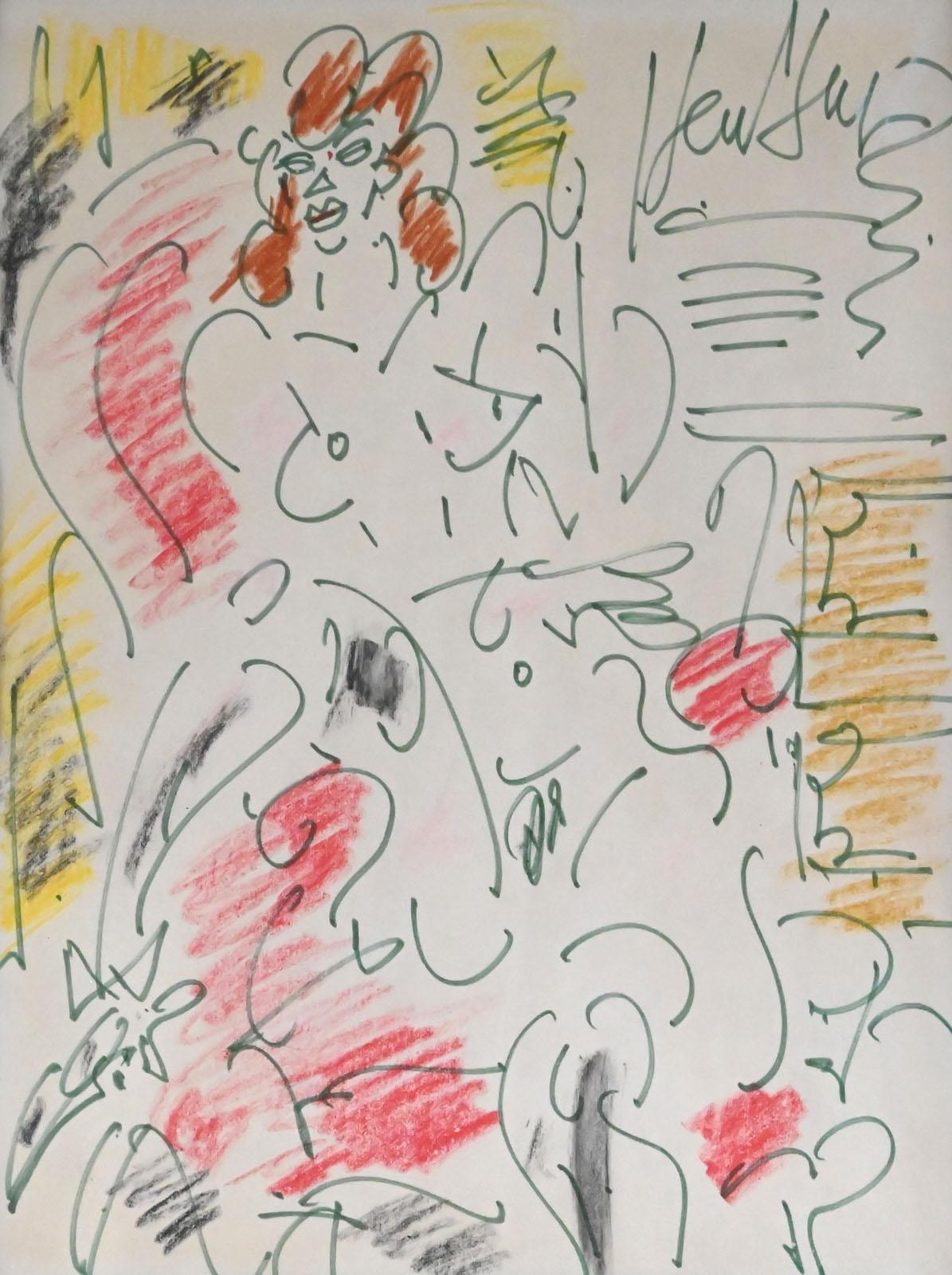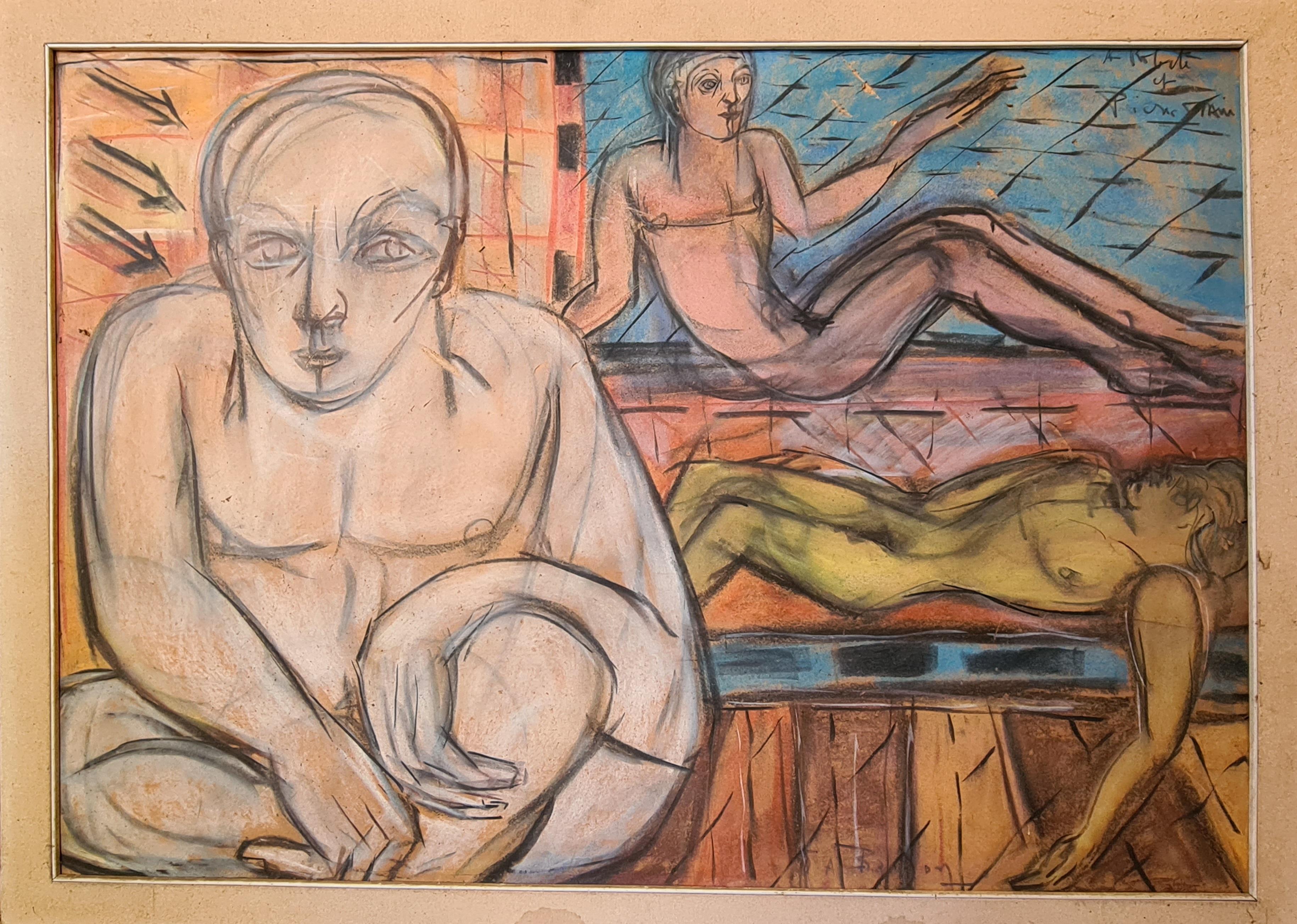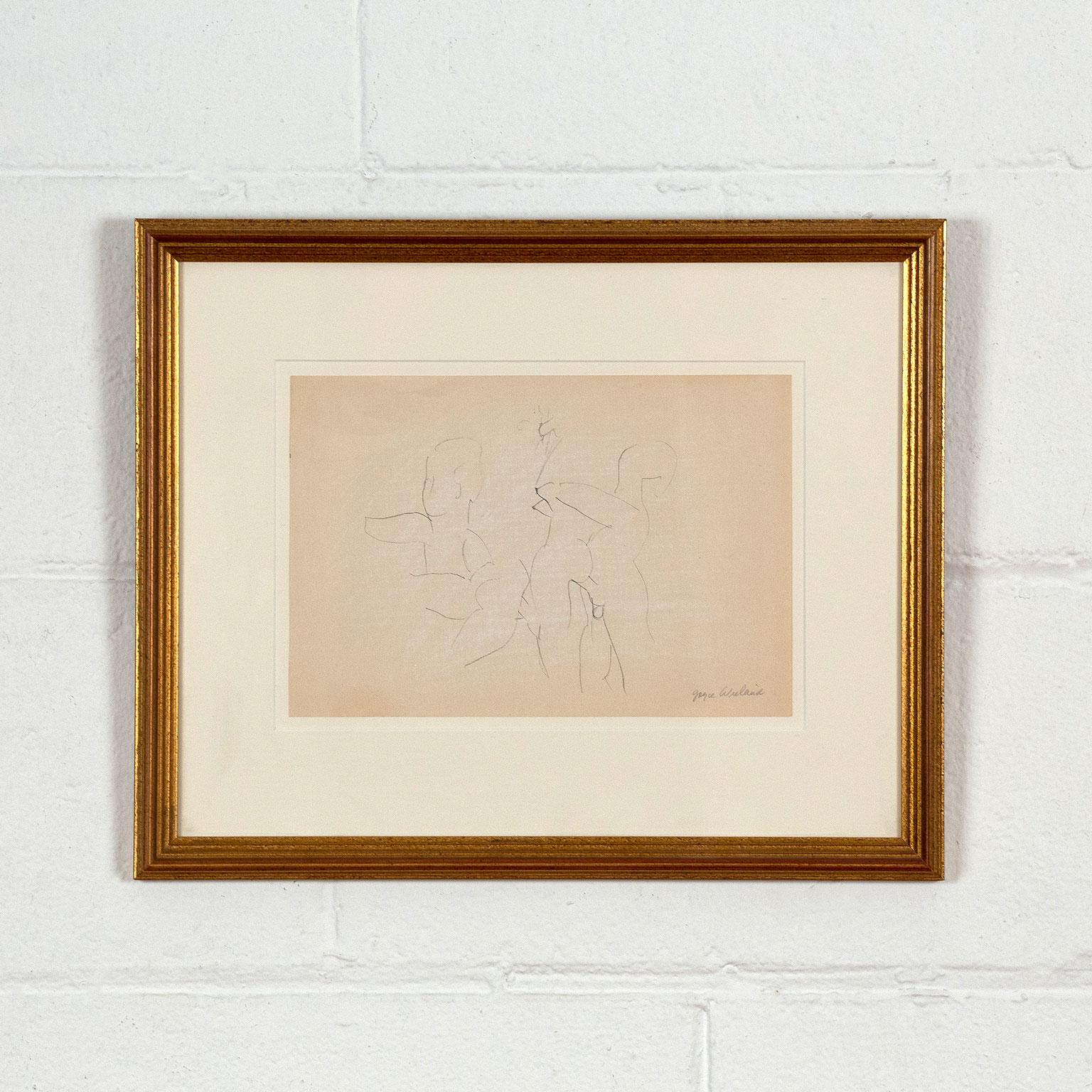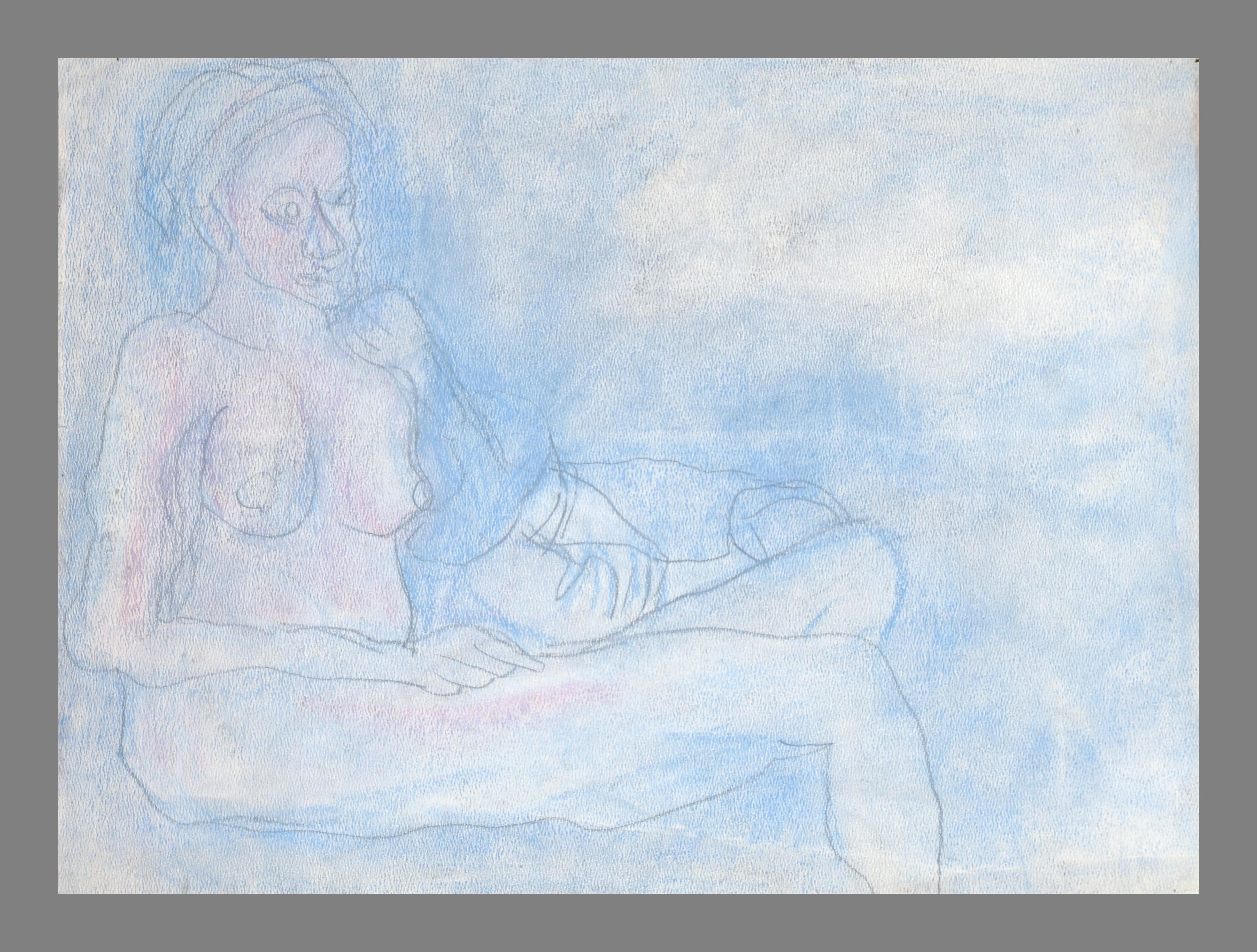Items Similar to Nude from Behind in Orange Pastel
Want more images or videos?
Request additional images or videos from the seller
1 of 7
UnknownNude from Behind in Orange PastelCirca 1990
Circa 1990
About the Item
Classic pastel on paper of seated nude female in orange, circa 1990.
Original artwork on paper displayed on a white mat with a gold border. Archival plastic sleeve and Certificate of Authenticity included. Artwork, 15.75"L x 21.75"H; mat, 24"L x 30"H.
Enjoy a single shipping fee on combined purchases you make from MAPSandART.
- Creation Year:Circa 1990
- Dimensions:Height: 30 in (76.2 cm)Width: 24 in (60.96 cm)Depth: 0.1 in (2.54 mm)
- Medium:
- Period:
- Condition:
- Gallery Location:Houston, TX
- Reference Number:

About the Seller
5.0
Gold Seller
These expertly vetted sellers are highly rated and consistently exceed customer expectations.
Established in 2001
1stDibs seller since 2015
1,029 sales on 1stDibs
- ShippingRetrieving quote...Ships From: Houston, TX
- Return PolicyA return for this item may be initiated within 7 days of delivery.
More From This SellerView All
- Nude in PinkLocated in Houston, TXElegant pencil and pastel nude female in pink, circa 1990. Original artwork on paper displayed on a white mat with a gold border. Archival plastic sleeve and ...Category
1990s Nude Drawings and Watercolors
MaterialsPencil, Pastel
- Nude in YellowLocated in Houston, TXDelightful pencil and pastel nude of a standing female, circa 1990. Original artwork on paper displayed on a white mat with a gold border. Mat fits a standard-sized frame. Archival ...Category
1990s Nude Drawings and Watercolors
MaterialsPencil, Pastel
- Nude in Pale Purples & GreensLocated in Houston, TXFantastic pencil and pastel female nude standing in shades of pale purples and greens, 1990s. Original artwork on paper displayed on a white mat with a gold border. Archival plastic...Category
1990s Nude Drawings and Watercolors
MaterialsPastel
- French Pastel NudeBy Kei MitsuuchiLocated in Houston, TXBold black and white pastel nude of a backside view of a reclined female figure by Kei Mitsuuchi, circa 1990. Original artwork on paper displayed on a white mat with a gold border. ...Category
1990s Nude Drawings and Watercolors
MaterialsPaper, Oil Pastel
- Male NudeBy M. LambertLocated in Houston, TXFrench pencil drawing of a nude male statue with bronze casting to leg by artist M. Lambert, circa 1930. Signed lower right. Original artwork on pap...Category
1930s Nude Drawings and Watercolors
MaterialsGraphite
- Nudes - Profile SketchesBy Werner BellLocated in Houston, TXPencil drawing of human profile in portrait by artist Werner Bell, circa 1960. Original artwork on paper displayed on a white mat with a gold border. Mat fits a standard-size f...Category
1960s Portrait Drawings and Watercolors
MaterialsPencil
You May Also Like
- Two Balinese Beauties (Mapeed), circa 1945By Johan Rudolf BonnetLocated in Amsterdam, NLRudolf Bonnet (1895-1978) 'Mepèèd' (Mapeed) Signed lower right Titled upper right Pastel on gouache pigmented paper, 57 x 34 cm In original carved ebo...Category
1940s Nude Drawings and Watercolors
MaterialsCrayon, Paper, Pastel, Gouache, Pencil
- Nu au fauteuilBy Gen PaulLocated in LE HAVRE, FRGEN PAUL (1895-1975) Nu au fauteuil Ink and pencil drawing Size: 26 x 20 cm Dimensions with frame: 43 x 37 cm Signed upper right. In perfect state of conservation Framing is FREE ...Category
20th Century French School Mixed Media
MaterialsMixed Media, Pastel, Handmade Paper, Color Pencil
- Futurist, Novecento Italiano, Mid Century Italian Painting, Figures at the BathsBy Anselmo BucciLocated in Cotignac, FRMid 20th Century Italian Futurist, Novecento Italiano, work on paper, signed bottom right and with dedication top right (see photos). The subject is bathers enjoying the delights of a spa and sauna with colourful tiling to the background. The classical figures languorously positioned in repose but the central 'white' figure in stark contrast. The play on colours gives the work a vibrancy. The drawing is possibly a preparatory sketch for a larger work or mural. A vibrant, exciting and colourful work incorporating the styles of Futurism and the Novecento Italiano movement and with the influences or artists such as Anselmo Bucci, Adami, Jean Helion, Maryan, Achille Funi and Ugo Guidi. Anselmo Bucci was born in 1887 in Fossombrone in the district of Pesaro. Even though he studied Classics, right from a tender age he showed a talent for drawing and, when his parents moved near to Florence, he was taught by the artist Francesco Salvini. In 1904 the family settled in Monza and so the boy was able to study for a year at the Accademia di Belle Arti di Brera, but he did not follow up this educational experience and in 1906 he left Italy for Paris where he came into contact with the Parisian avant-garde, met fellow Italian artists such as Severini and Modigliani, and made friends with Picasso, Utrillo and Apollinaire. In 1907 he showed a painting at the Salon, but these Parisian years were most important for his love of engraving techniques – etching and dry point that enabled him to fully develop his themes characterised by movement. On the outbreak of war in 1915 he returned to Italy and he enlisted in the same battalion as several Futurist artists such as Martinetti, Boccioni, Sant’Elia and Carlo Erba. In 1914 he won the silver medal at the Mostra dell’Incisione (Exhibition of Engravings) at Florence. In 1917 in Paris he published pictures of war scenes entitled “Croquis du Front Italien”. In 1919 he printed twelve lithographs entitled “Finis Austriae” again showing events from the war. At the end of the war he lived between Milan and Paris and he dedicated his time completely to his art with personal exhibitions, exhibiting at all the most important Italian and French shows, in Belgium, Holland and England. In 1922, he established the group “Movimento del Novecento”, (Novecento Italiano), (20th century Movement) a joint venture with the artists Sironi, Funi, Oppi, Malerba, Dudreville and Marussig. Their aim was to return to figurative art in contrast with the growing extremism of the Avant-gardists. In 1925 he worked on the illustration of the first edition of Kipling’s The Jungle Book producing eight dry point plates. In the early 30’s he lived in Bucci, Trieste, where he worked on the furnishing of the steamships for the Trieste Navigazione Libera, at the same time he continued to work on many book illustrations. During the second European war he adapted to being a war artist recording the events of the war as he had done previously. Indeed the engravings depicting battles of the Marines and the Air Force belong to this period. In 1945, following the bombing of his house in Milan, he returned to Monza to his father’s home where he remained until his death. Futurism was an Italian art movement of the early twentieth century that aimed to capture in art the dynamism and energy of the modern world. Futurism was launched by the Italian poet Filippo Tommaso Marinetti in 1909. On 20 February he published his Manifesto of Futurism on the front page of the Paris newspaper Le Figaro. Among modernist movements futurism was exceptionally vehement in its denunciation of the past. This was because in Italy the weight of past culture was felt as particularly oppressive. In the Manifesto, Marinetti asserted that ‘we will free Italy from her innumerable museums which cover her like countless cemeteries’. What the futurists proposed instead was an art that celebrated the modern world of industry and technology: We declare…a new beauty, the beauty of speed. A racing motor car…is more beautiful than the Victory of Samothrace. (A celebrated ancient Greek sculpture in the Louvre museum in Paris.) Futurist painting used elements of neo-impressionism and cubism to create compositions that expressed the idea of the dynamism, the energy and movement, of modern life. Chief artists associated with futurism were Giacomo Balla, Umberto Boccioni, Gino Severini. After the brutality of the first world war, many artists rejected the avant-garde notions of futurism and other pre-war movements, by using more traditional and reassuring approaches, a phenomenon described as the ‘return to order’. Novecento Italiano was founded by Anselmo Bucci (1887–1955), Leonardo Dudreville (1885–1975), Achille Funi, Gian Emilio Malerba (1880–1926), Pietro Marussig, Ubaldo Oppi, and Mario Sironi. Motivated by a post-war "call to order", they were brought together by Lino Pesaro, a gallery owner interested in modern art, and Margherita Sarfatti, a writer and art critic who worked on Italian dictator Benito Mussolini's newspaper, The People of Italy (Il Popolo d'Italia). Sarfatti was also Mussolini's mistress. The movement was officially launched in 1923 at an exhibition in Milan, with Mussolini as one of the speakers. The group was represented at the Venice Biennale of 1924 in a gallery of its own, with the exception of Oppi, who exhibited in a separate gallery. Oppi's defection caused him to be ejected from the group, which subsequently split and was reformed. The new Novecento Italiano staged its first group exhibition in Milan in 1926. Several of the artists were war veterans; Sarfatti had lost a son in the war. The group wished to take on the Italian establishment and create an art associated with the rhetoric of fascism. The artists supported the fascist regime and their work became associated with the state propaganda department, although Mussolini reprimanded Sarfatti for using his name and the name of fascism to promote Novecento. The name of the movement (which means 1900s) was a deliberate reference to great periods of Italian art in the past, the Quattrocento and Cinquecento (1400s and 1500s). The group rejected European avant garde art and wished to revive the tradition of large format history painting in the classical manner. It lacked a precise artistic programme and included artists of different styles and temperament, for example, Carrà and Marini. It aimed to promote a renewed yet traditional Italian art. Sironi said, “if we look at the painters of the second half of the 19th century, we find that only the revolutionary were great and that the greatest were the most revolutionary”; the artists of Novecento Italiano “would not imitate the world created by God but would be inspired by it”. Despite official patronage, Novecento art did not always have an easy ride in Fascist Italy. Mussolini was personally uninterested in art and divided official support among various groups so as to keep artists on the side of the regime. Opening the exhibition of Novecento art in 1923 he declared that “it is far from my idea to encourage anything like a state art. Art belongs to the domain of the individual. The state has only one duty: not to undermine art, to provide humane conditions for artists, to encourage them from the artistic and national point of view." The movement was in competition with other pro-Fascist movements, especially Futurism and the regionalist Strapaese movement. Novecento Italiano also met outright opposition. Achille Starace, the General Secretary of the Fascist Party, attacked it in the Fascist daily press and there was virulent criticism of its “un-Italian" qualities by artists and critics. In the 1930s, a group of professors and students at the Accademia di Brera established an opposition group to Novecento Italiano. Among them was the director of the academy Aldo Carpi, and students Afro, Aldo Badoli, Aldo Bergolli, Renato Birolli, Bruno Cassinari, Cherchi, Alfredo Chighine, Grosso, Renato Guttuso, Dino Lanaro, Giuseppe Migneco, Mantica, Ennio Morlotti, Aligi Sassu, Ernesto Treccani, Italo Valenti, and Emilio Vedova (and later Giuseppe Ajmone...Category
Mid-20th Century Futurist Figurative Paintings
MaterialsPaper, Pastel, Crayon, Pencil
- EnterBy Joyce WielandLocated in Toronto, OntarioJoyce Wieland (1931-1998) is one of the most accomplished and versatile Canadian artists. She achieved a level of commercial and critical success in her lifetime that was exceptional...Category
Late 20th Century Feminist Nude Drawings and Watercolors
MaterialsPaper, Graphite, Pastel
- Reclining Nude - Blue Abstract FigurativeBy Louis NadaliniLocated in Soquel, CAAbstract figurative reclining nude by Louis Nadalini (American, 1927-1995). This piece is unsigned, but was acquired with a collection of Nadalini work. Unframed (First image shows w...Category
1980s Abstract Expressionist Figurative Drawings and Watercolors
MaterialsPaper, Pastel, Pencil
- 'Self Portrait' original pastel and graphite drawing signed by Sandra SweeneyBy Sandra SweeneyLocated in Milwaukee, WIFollowing in line with artists before her, like Rembrandt and van Gogh, Sandra Sweeny here presents a self portrait. The image is direct but subtle in its handling of materials, but ...Category
1970s Contemporary Nude Drawings and Watercolors
MaterialsGraphite, Paper, Pastel
Recently Viewed
View AllMore Ways To Browse
Pastel Artwork
Nude From Behind
Nude Oranges
Nudes In Pastels
Classic Vintage Nudes
Nude Female Pencil Drawings
Nude Female Behind
Pastel Art 30x24
Nude Line Drawing Female
Male Nude Watercolor
Nude Female Pencil Drawings
Nude Female Charcoal
Antique Nude Drawings and Watercolors
Male Nude Watercolors And Drawings
Female Nude Drawing Sketches
Charcoal Drawing Female Nude
Vintage Drawing Nude
Black Charcoal Nude
